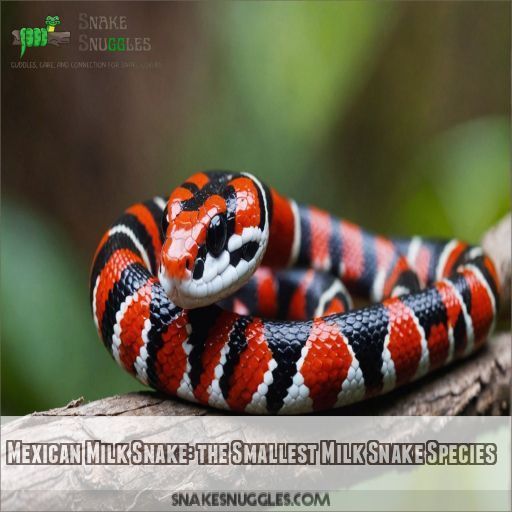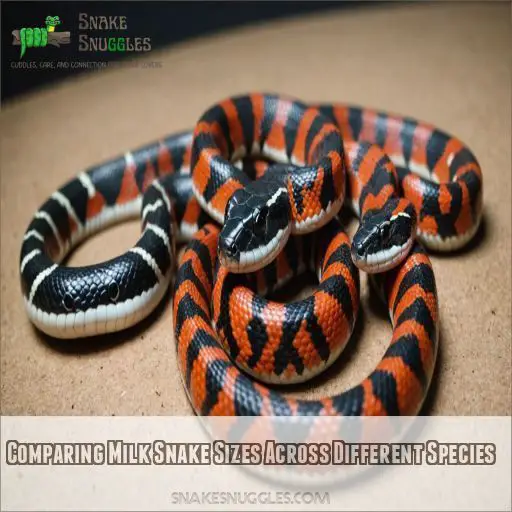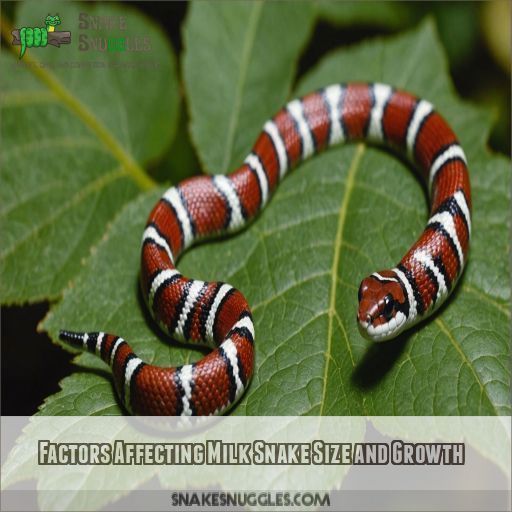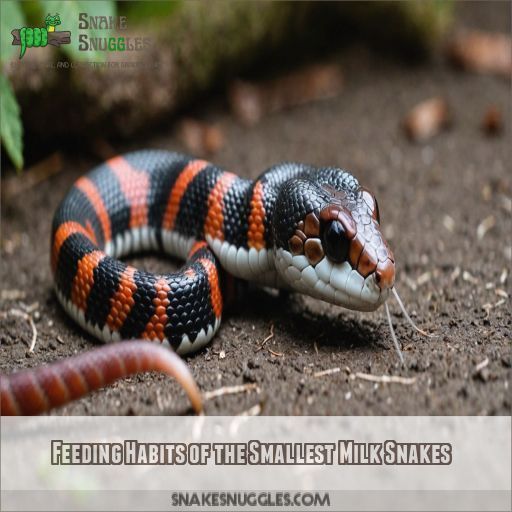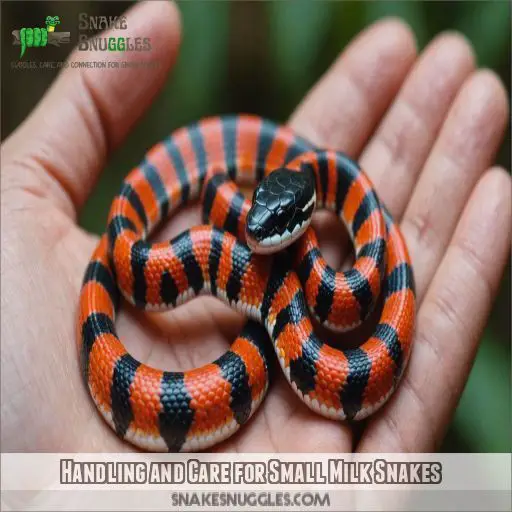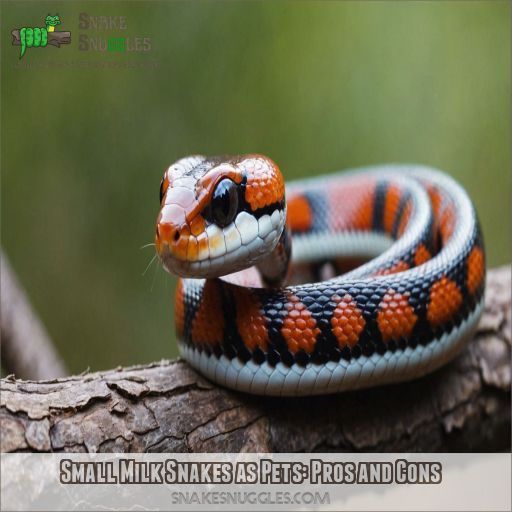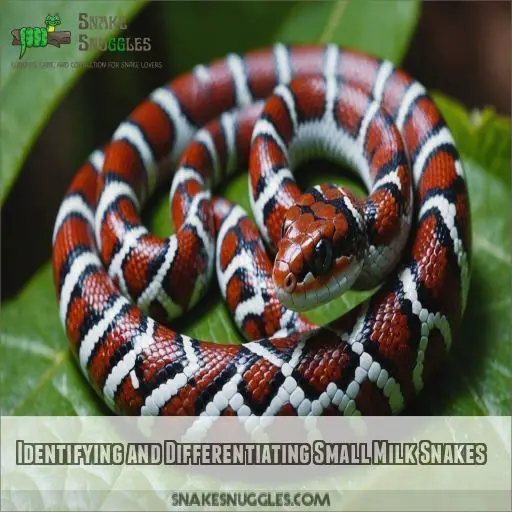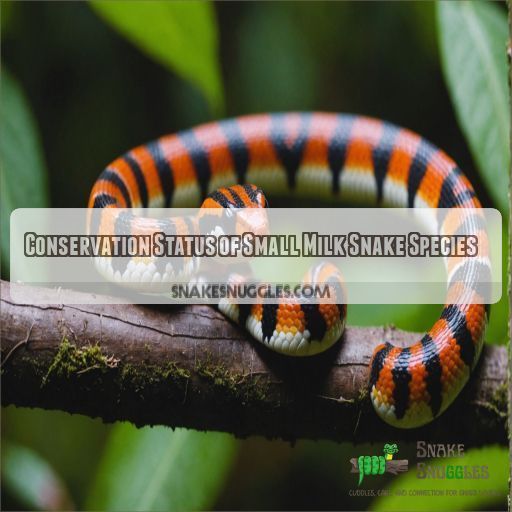This site is supported by our readers. We may earn a commission, at no cost to you, if you purchase through links.
 You’re curious about the smallest milk snake? Well, you’re in luck! The Mexican milk snake is the tiniest of the milk snake family, reaching a maximum length of just 2.5 feet.
You’re curious about the smallest milk snake? Well, you’re in luck! The Mexican milk snake is the tiniest of the milk snake family, reaching a maximum length of just 2.5 feet.
Despite their small size, these snakes pack a big punch with their vibrant red, black, and white banding pattern, which cleverly mimics the deadly coral snake.
Native to Mexico and parts of Central America, these little serpents have adapted to thrive in diverse climates.
As you learn more about these fascinating creatures, you’ll discover the secrets behind their remarkable adaptability and what makes them such great pets.
Table Of Contents
- Key Takeaways
- Mexican Milk Snake: the Smallest Milk Snake Species
- Comparing Milk Snake Sizes Across Different Species
- Factors Affecting Milk Snake Size and Growth
- Housing Requirements for Small Milk Snakes
- Feeding Habits of the Smallest Milk Snakes
- Handling and Care for Small Milk Snakes
- Breeding Considerations for Mexican Milk Snakes
- Small Milk Snakes as Pets: Pros and Cons
- Identifying and Differentiating Small Milk Snakes
- Conservation Status of Small Milk Snake Species
- Frequently Asked Questions (FAQs)
- What is the smallest kind of milk snake?
- Do milk snakes stay small?
- What is the best milk snake for beginners?
- What is the most docile milk snake?
- Are small milk snakes more prone to escape from enclosures?
- How do small milk snakes adapt to new environments quickly?
- Can small milk snakes recognize their owners or handlers easily?
- Are small milk snakes more susceptible to diseases or infections?
- Do small milk snakes have specific temperature requirements at night?
- Conclusion
Key Takeaways
- You’ll want to remember that the smallest milk snake species is the Mexican milk snake, which grows to a maximum length of just 2.5 feet—that’s one tiny but mighty serpent!
- When it comes to identifying your tiny milk snake, don’t get confused with lookalikes—keep an eye out for that distinctive red, black, and white banding pattern, and you’ll be a milk snake master identifier in no time!
- To keep your small milk snake happy and healthy, you’ll need to provide a proper enclosure with a heat source, humidity, and hiding spots—think of it as creating a cozy home for your slithery friend!
- As a responsible milk snake owner, you play a big part in their conservation—by supporting responsible breeding programs and prioritizing your pet’s welfare, you’re helping to safeguard the future of these incredible creatures.
Mexican Milk Snake: the Smallest Milk Snake Species
You’re about to meet the tiniest member of the milk snake family: the Mexican milk snake. This pint-sized serpent packs all the charm of its larger cousins into a compact frame, typically maxing out at just 2.5 feet long.
Average Length of 1.5-2.5 Feet
You might be surprised to learn that the smallest milk snake species is the Mexican milk snake.
These pint-sized serpents typically measure between 1.5 and 2.5 feet long, making them perfect for compact spaces.
Don’t let their size fool you, though; they’re still fascinating creatures!
Whether you’re a seasoned snake enthusiast or just curious about these tiny treasures, understanding their unique size can help you provide the best care possible.
Distinctive Red, Black, and White Banding
You’ll be mesmerized by the Mexican milk snake’s vibrant attire! These pint-sized serpents sport a stunning trio of colors: red, black, and white. Their bands wrap around their bodies like tiny, living candy canes. Each snake’s pattern is as unique as a fingerprint, making them a treat for the eyes. Nature’s paintbrush sure did a number on these little beauties!
Mimicry of Coral Snakes for Protection
You’ll be amazed by the Mexican milk snake’s clever disguise! These tiny tricksters have evolved to mimic the deadly coral snake’s striking pattern. It’s a brilliant defense strategy called Batesian mimicry. Here’s why it works:
- Predators mistake them for venomous coral snakes
- The bold red, black, and white bands act as a warning signal
- This mimicry gives them an evolutionary advantage, boosting survival rates
Talk about a snake in sheep’s clothing!
Habitat Preferences and Distribution Range
While these tiny mimics might fool predators, they’re serious about their homes.
You’ll find Mexican milk snakes slithering through a variety of habitats, from dry deserts to lush forests.
They’re native to Mexico and parts of Central America, adapting to different climates like a chameleon changes colors.
But watch out – human impact and climate change are shaking up their natural haunts!
Behavioral Characteristics of Mexican Milk Snakes
Mexican milk snakes are the night owls of the snake world.
They come alive after dark, slithering about in search of a midnight snack.
These pint-sized serpents are masters of disguise, mimicking Coral Snakes to keep predators at bay.
If you startle one, it might put on a show – hissing, tail-rattling, or even playing dead.
Talk about a snake with attitude!
Comparing Milk Snake Sizes Across Different Species
Now that we’ve met the pint-sized Mexican Milk Snake, let’s size up the competition! Milk snakes come in a variety of lengths, each with its own unique charm. Here’s a quick rundown of how they stack up:
- Mexican Milk Snake: The petite powerhouse, maxing out at 2.5 feet.
- Sinaloan Milk Snake: A mid-sized marvel, stretching to 3-4 feet.
- Nelson’s Milk Snake: Another medium contender, also reaching 3-4 feet.
It’s like comparing fun-sized candy bars to king-sized ones – they’re all sweet, just in different packages! While most milk snakes hover around the 2-foot mark, some subspecies can grow up to a whopping 4-5 feet. Talk about a growth spurt! But don’t worry, these longer snakes are still more "garden hose" than "anaconda." No matter their size, all milk snakes share that stunning red, black, and white pattern that’ll make you do a double-take.
Factors Affecting Milk Snake Size and Growth
You might think a milk snake’s size is set in stone, but there’s more to these slithery stunners than meets the eye. From genetics to diet, several factors play a role in determining just how big (or small) your scaly friend will grow.
Genetic Influences on Milk Snake Size
You might be surprised to learn that your milk snake’s size isn’t just about what it eats! Genetics play a huge role in determining how big your scaly friend will grow. Let’s take a peek at some of the genetic factors that influence milk snake size:
| Genetic Factor | Impact on Size | Example |
|---|---|---|
| Growth Genes | Determine overall growth potential | Fast-growing vs. slow-growing snakes |
| Color Genes | Can affect metabolism and size | Albino snakes may grow differently |
| Inherited Traits | Pass down size characteristics | Offspring of larger parents tend to be larger |
These tiny genetic differences can make a big impact on your snake’s final size!
Environmental Factors Impacting Growth Rate
- Consistent temperature gradient (75-90°F)
- Proper humidity levels (50-60%)
- Stress-free habitat with hiding spots
- Regular handling for socialization
Nutritional Considerations for Optimal Growth
Nutrition is super important for your milk snake’s growth.
You’ll want to give them a variety of food, making sure the prey is the right size.
Think of it as a snake’s version of a balanced meal plan!
Don’t forget about supplements – calcium and vitamin D3 are essential for healthy bone development.
Keep an eye on your snake’s progress with growth charts, and you’ll be on track for raising a happy, healthy serpent.
Influence of Geographic Origin on Size Variation
Ever wondered why your milk snake might be a bit different from your friend’s?
It’s not just chance!
Where these tiny serpents come from plays a big role in their size.
Climate, food availability, and habitat all shape how big (or small) they grow.
A milk snake from a chilly mountain might be smaller than its cousin from a warm valley.
It’s like nature’s own sizing chart!
Age-related Changes in Milk Snake Length
As your milk snake slithers through life, you’ll notice its length changing like a living yardstick.
These tiny terrors start small but grow quickly in their first few years.
By age three, they’re usually close to full size.
But don’t worry, they won’t outgrow your love!
Keep an eye on their shedding patterns – it’s a great way to track their growth milestones.
Housing Requirements for Small Milk Snakes
When housing tiny milk snakes, you’ll need to create a cozy home that meets their specific needs. Let’s explore the essential elements for crafting the perfect habitat for your pint-sized serpentine friend, from enclosure size to temperature control.
Minimum Enclosure Dimensions for Mexican Milk Snakes
When it comes to housing your pint-sized Mexican milk snake, size matters!
You’ll want to provide a cozy home that’s at least 24x18x18 inches.
Think of it as your snake’s studio apartment – snug, but with room to stretch.
For a more luxurious setup, aim for 36x18x18 inches or larger.
Ideal Temperature and Humidity Levels
Now that you’ve got the right size enclosure, let’s talk temperature and humidity. Your tiny milk snake needs a cozy climate to thrive. Here’s what you’ll want to aim for:
- A warm side at 85-90°F (think tropical vacation)
- A cool side at 75-80°F (perfect for snake naps)
- Humidity around 50-60% (not too wet, not too dry)
Creating this temperature gradient is key for your snake’s comfort and health.
Substrate Options for Small Milk Snake Habitats
Choosing the right substrate for your tiny milk snake’s home is important!
Think of it as picking the perfect carpet for your slithery friend.
Cypress mulch is a top pick, holding moisture like a champ.
Coco coir is another fan favorite, mimicking their natural digs.
It’s like giving your snake its own mini-forest floor to explore!
Essential Accessories for a Comfortable Environment
You’ll want to deck out your tiny milk snake’s home with all the essentials.
Think of it as a cozy apartment for your scaly friend!
Must-haves include a water bowl for sipping and soaking, a couple of snug hides for security, and a trusty thermometer to keep tabs on the temperature.
Don’t forget the substrate – it’s like carpet for your snake’s belly!
These accessories will make your milk snake feel right at home.
Importance of Proper Ventilation and Lighting
You’ve got your tiny milk snake settled in, but don’t forget about the air they breathe and the light they see! Proper ventilation and lighting are like the lungs and eyes of your snake’s home. Here’s why they’re super important:
- Prevents mold growth and stagnant air
- Helps maintain ideal humidity levels
- Supports natural day/night cycles
- Allows for better temperature regulation
Feeding Habits of the Smallest Milk Snakes
You might think tiny milk snakes need tiny meals, but these pint-sized predators pack a surprisingly hefty appetite. Let’s explore the feeding habits of the smallest milk snakes and uncover the secrets to keeping these miniature constrictors happy and well-fed in captivity.
Dietary Preferences in the Wild
In the wild, the smallest milk snakes are adaptable hunters with a diverse menu.
You’ll find these tiny serpents chowing down on a buffet of small mammals, birds, and even other snakes!
Their diet varies with the seasons and what’s available in their habitat.
These little guys are masters of stealth, using their slender bodies to sneak into tight spaces and surprise their prey.
Talk about a sneaky snack attack!
Appropriate Prey Size for Small Milk Snakes
Now that we’ve explored their wild diet, let’s talk about what to feed your tiny milk snake buddy at home.
You’ll want to match the prey size to your snake’s size – it’s like finding the perfect fit for a snake sweater!
For those itty-bitty Mexican milk snakes, pinky mice are usually just right.
As your scaly friend grows, you can gradually increase the meal size.
Feeding Frequency and Schedule
You’ll want to tailor your tiny milk snake’s feeding schedule to its age and size.
Baby snakes need more frequent meals, about every 5-7 days, while adults can go 10-14 days between feedings.
Think of it like a growing kid versus a full-grown adult – different appetites!
Set a feeding routine and stick to it, just like you would for any beloved pet.
Nutritional Requirements for Healthy Growth
To keep your tiny milk snake healthy and growing, you’ll need to focus on proper nutrition. Here’s what you should keep in mind:
- Calcium is key – dust prey with calcium powder
- Vitamins are important – use a reptile multivitamin supplement
- Variety is the spice of life – offer different prey types
- Frequency matters – feed young snakes more often
Potential Feeding Issues and Solutions
Milk snakes are usually enthusiastic eaters, but you might encounter some hiccups along the way. Food refusal can be a head-scratcher, but don’t panic!
It’s often due to stress or improper prey size. If your tiny friend is turning up its nose, try offering smaller meals or adjusting the feeding schedule.
Keep an eye out for regurgitation issues too – they’re a red flag for overfeeding or nutritional deficiencies. Remember, patience is key when dealing with these pint-sized serpents!
Handling and Care for Small Milk Snakes
You’ll be thrilled to learn that the smallest milk snake, the Mexican Milk Snake, is a joy to handle with the right techniques. Let’s explore how to safely care for these tiny serpents, from proper handling methods to health monitoring and stress reduction strategies that’ll keep your scaly friend happy and thriving.
Safe Handling Techniques for Mexican Milk Snakes
Now that you’ve mastered feeding your Mexican milk snake, it’s time to learn safe handling techniques! You’ll want to invest in a good pair of handling snake hooks to prevent any slithery escapes. Here are three essential tips to keep in mind:
- Use support handling methods to keep your snake secure and calm.
- Practice snake calm techniques, like gentle stroking or simply letting them explore.
- Have an injury response plan in place, just in case – and don’t hesitate to reach out to snake professionals or the milk snake care community for guidance.
Health Monitoring and Common Issues
Now that you’re handling your Mexican milk snake with care, it’s time to keep an eye on their health. Look out for signs of respiratory infections, parasitic infestations, skin problems, and dehydration risks. Regular check-ups with a reptile shop expert can help detect metabolic disorders early on. With proper care, your tiny serpent can live a happy, 12-year life.
Shedding Process and Assistance
You’ll notice your milk snake’s skin loosening and eventually peeling off as it sheds.
Don’t panic if the skin gets stuck.
A gentle misting or a shallow water bath can help.
Keep humidity levels around 50-60% to prevent skin problems.
Shedding frequency varies, but a shedding aid can help if needed.
Monitor your snake’s progress, and consult a vet if issues persist.
Stress Reduction Strategies for Small Snakes
To keep your small milk snake stress-free, try these four strategies:
- Enrich their habitat: Add new objects to explore, like rocks or plants, to keep them engaged.
- Handle with care: Support their body and avoid sudden movements to reduce anxiety.
- Maintain a calm environment: Play soothing sounds, like rain or nature sounds, to create a peaceful atmosphere.
- Provide a varied diet: Rotate their food to keep mealtime interesting and stimulating.
Importance of Regular Veterinary Check-ups
As a responsible milk snake owner, it’s really important to prioritize preventative care through regular veterinary check-ups.
Early detection of health issues, parasite control, and disease prevention are key to your pet’s well-being.
Schedule annual visits, and don’t hesitate to reach out to a reptile-savvy vet if you notice any changes, especially during brumation.
Your milk snake’s health depends on it!
Breeding Considerations for Mexican Milk Snakes
You’re thinking about breeding Mexican milk snakes – a cool challenge that needs careful planning and attention to detail. As you get started, you’ll need to understand how they mate, lay eggs, and how to care for the babies to make sure your breeding program is successful and healthy.
Mating Behavior and Seasonality
When you’re thinking about breeding Mexican milk snakes, you’ll want to understand their mating habits and when they’re most likely to breed.
Mating rituals usually happen in May, with males doing a fancy dance to get the girls’ attention.
Keep in mind that their winter sleep can affect how well they breed.
Getting the sexes right and pairing them up is really important for a successful breeding program.
Egg-laying Process and Incubation
Now that you’ve learned about milk snake mating, let’s talk egg-laying!
Female Mexican milk snakes typically lay 3-24 eggs in June and July.
They often choose humid, hidden spots like under rocks or logs.
As a responsible breeder, make sure the eggs are healthy and incubate them at the right temperature (around 80F) for about 60-70 days.
Your reptile shop may offer guidance on good incubation techniques.
Care for Hatchlings and Juveniles
Congratulations, you’ve got a batch of adorable milk snake hatchlings! Now, it’s time to care for these tiny bundles of joy. Provide a starter setup with a 12x12x18 enclosure, heat mat, and hiding places. Feed them pinkie mice every 5-7 days, and mist their home daily. Handle them gently, and monitor their growth and health closely.
Genetic Factors in Breeding Programs
Breeding Mexican milk snakes is a fun and rewarding experience, but you want to make sure your snakes are healthy and happy. Here are some things to keep in mind when it comes to genetics:
- Genetic diversity: Aim for a mix of genetic traits to prevent inbreeding and promote robustness.
- Inbreeding: Avoid breeding snakes that are too closely related, as this can lead to health concerns.
- Selective breeding: Focus on desirable traits like color morphs or scale count, but don’t sacrifice overall health.
- Morphs: Be aware that certain morphs can be more prone to health issues, so monitor them closely.
- Health concerns: Prioritize snakes’ overall health and well-being over specific traits or characteristics.
Ethical Considerations in Captive Breeding
When you’re thinking about captive breeding, you need to think about the ethics. It’s not just about meeting market demand or turning a profit. You need to prioritize genetic diversity, welfare standards, and conservation impact. Be cautious of interbreeding and release programs that can harm local ecosystems. Remember, your reptile shop can make a difference in the milk snake’s future.
Small Milk Snakes as Pets: Pros and Cons
If you’re considering bringing a small milk snake into your home, you’re likely weighing the pros and cons of caring for these tiny serpents. As a potential owner, you’ll want to know whether the advantages of keeping a smaller milk snake species, like the Mexican milk snake, outweigh the challenges associated with their care.
Advantages of Keeping Smaller Milk Snake Species
If you’re thinking about getting a milk snake as a pet, smaller species are a great choice! You’ll enjoy space-saving enclosures, lower costs, and easy handling. Plus, they require less food and produce less waste. Whether you’re a seasoned snake enthusiast or a newcomer to the milk snake world, smaller species can make wonderful, stress-free companions.
Challenges Associated With Their Care
Caring for small milk snakes can be a challenge! You’ll need to master housing maintenance, humidity control, and temperature fluctuations to keep your pet comfortable.
Feeding variability can also be tricky, and keeping a close eye on their health is important.
Join a milk snake care group to connect with other owners and get tips on social needs, brumation, and starter setups.
Suitability for Beginners Vs. Experienced Keepers
As a beginner, you might wonder if small milk snakes are suitable for you. Compared to other species, they’re relatively beginner-friendly, with a calm temperament. However, their specific housing and feeding needs can be challenging. Experienced keepers will appreciate the unique characteristics of these tiny serpents, but newcomers should research and prepare carefully before bringing one home.
Lifespan and Long-term Commitment
As you consider bringing a small milk snake into your life, remember that their lifespan is around 12 years. That’s a long-term commitment to reptile care! You’ll need to think about housing, feeding, and veterinary care for over a decade. You really need to be honest with yourself about whether you’re ready for this responsibility.
Legal Considerations and Regulations
When considering a small milk snake as a pet, you must navigate the complex web of laws and regulations. Check with your state’s division of fisheries and wildlife for permit requirements and captivity regulations. Some states have species protection laws, while others have ownership restrictions. Research reputable reptile shops and websites to make an informed decision.
Identifying and Differentiating Small Milk Snakes
As you explore the fascinating world of milk snakes, you’ll want to know how to identify and differentiate the smallest species, the Mexican Milk Snake, from its look-alikes.
With its distinctive red, black, and white banding, this tiny serpent can be tricky to tell apart from other small snakes.
Don’t worry, we’ve got some expert tips and tricks to help you become a milk snake master identifier!
Key Physical Characteristics of Mexican Milk Snakes
If you’re looking at a Mexican Milk Snake, you’ll notice their distinctive head patterns, featuring a light-colored "Y" or "V" within a reddish-brown patch. Their bodies boast a bold, alternating pattern of light gray to tan and reddish-brown blotches, bordered in black. Smooth scales give them a shiny appearance, while their bellies display an irregular black and white checkerboard pattern.
Distinguishing From Other Small Snake Species
To distinguish your tiny milk snake from other small snake species, take a closer look. You might be surprised at how often they’re mistaken for garter snakes, ringneck snakes, or even eastern racers. Here are three key differences to keep in mind:
- Pattern: Milk snakes have a distinctive red, black, and white banding pattern, whereas garter snakes have stripes.
- Head shape: Milk snakes have a more pointed snout than ringneck snakes.
- Behavior: Eastern racers are generally more aggressive than milk snakes when handled.
Color Variations and Morphs in Captivity
In the context of milk snakes in captivity, you’ll find a stunning array of color variations and morphs. These genetic wonders are the result of careful, ethical breeding programs. From rare morphs like the "Extreme Piebald" to the more common "Albino," each unique pattern is a demonstration of the intricate science of morph genetics and color inheritance.
Common Misidentifications and Look-alikes
When trying to identify a small milk snake, it’s easy to get confused with similar species. Watch out for venomous lookalikes like coral snakes, which have a similar banding pattern (Source). Pay attention to head shape differences and body color mimicry. Mexican milk snakes are often mistaken for copperheads or rattlesnakes, but their unique "Y" or "V" pattern on the head sets them apart .
Using Scale Counts and Patterns for Identification
Now that we’ve covered common misidentifications, let’s get to the nitty-gritty of identifying small milk snakes. You’ll want to examine their scales and patterns closely. Here are 4 key things to look out for:
- Scale count variations: Some milk snakes have fewer or more scales than others.
- Pattern anomalies: Look for irregularities in the snake’s banding or blotches.
- Regional differences: Milk snakes from different regions may display distinct patterns or coloration.
- Milk snake morphs: Some captive-bred snakes may exhibit unique, bred-for characteristics.
Conservation Status of Small Milk Snake Species
As you learn about the smallest milk snake species, you’ll want to know the conservation status of these tiny serpents. The Mexican milk snake, being the smallest, faces threats to its habitat and population, but fortunately, conservation efforts and responsible pet ownership can help preserve this species.
Current Population Trends in the Wild
You’re curious about the smallest milk snake’s population trends in the wild. Let’s take a look. Currently, their numbers are declining due to various threats . Here’s a snapshot of the situation:
| Threat | Impact |
|---|---|
| Habitat loss | Reduced living space |
| Predator impact | Increased mortality |
| Climate change | Altered ecosystems |
| Disease outbreaks | Weakened populations |
These tiny serpents face big challenges (Source). As we learn more about their struggles, we can work on conservation efforts that make a difference.
Threats to Mexican Milk Snake Habitats
You’re curious about the threats to Mexican Milk Snake habitats? Well, let’s get real – these tiny serpents are facing some big challenges! Habitat loss, climate change, pollution, and invasive species are all taking a toll on their populations. Here are some key threats to keep in mind:
- Habitat destruction due to human development and agriculture
- Climate change altering their food supply and shelter
- Pollution from pesticides and industrial waste
- Invasive species competing for resources and habitat
Conservation Efforts and Protected Areas
You’re now aware of the threats to Mexican Milk Snake habitats, but what’s being done to protect them? Conservation efforts are underway, focusing on creating protected areas to combat habitat fragmentation. Community involvement is super important, with local groups working together to preserve habitats. Success stories include the establishment of wildlife corridors, giving these tiny serpents a safer future (Source).
Role of Captive Breeding in Species Preservation
You’re now part of the milk snake conservation crew! Captive breeding is a key part of protecting these snakes. By supporting responsible breeding programs, you’re helping to:
- Captive population growth: A safeguard against extinction
- Increased species survival rates: A result of controlled environments and expert care
- Breeder responsibility: Promoting animal welfare and conservation
- Conservation partnerships: Collaborations that drive positive change
Importance of Responsible Pet Ownership
As a milk snake owner, you play a big part in their conservation. To be a responsible pet owner, consider the following:
| Responsible Ownership | Why It Matters |
|---|---|
| Ethical sourcing | Makes sure your pet isn’t harming wild populations. |
| Habitat knowledge | Provides a comfortable, stress-free environment. |
| Proper diet and vet care | Keeps your milk snake healthy and thriving. |
Frequently Asked Questions (FAQs)
What is the smallest kind of milk snake?
You’re in for a treat! Meet the Mexican Milk Snake, the smallest of the bunch, reaching a mere 5 feet in length, with some specimens as tiny as 5-2 feet – a pint-sized bundle of slithery joy!
Do milk snakes stay small?
You’re wondering if milk snakes stay small? Well, some species, like the Mexican Milk Snake, remain relatively tiny, reaching only 5 feet in length, while others can grow up to 4-5 feet, so it really depends on the type!
What is the best milk snake for beginners?
Are you ready to dive into the world of milk snakes? As a beginner, you’ll love the Mexican Milk Snake – it’s small, gentle, and easy to care for, making it the perfect scaly sidekick for your herpetological journey!
What is the most docile milk snake?
You’re looking for a laid-back milk snake! The Mexican Milk Snake is often considered the most docile, with a calm demeanor, making it perfect for beginners. Just remember, each snake has its own personality, so handle with care!
Are small milk snakes more prone to escape from enclosures?
Small milk snakes are escape artists, they can squeeze through tiny openings like Houdini. That’s why it’s super important to make sure their enclosure is escape-proof. A secure, well-ventilated habitat will keep your slithery friend safe and sound, giving you peace of mind.
How do small milk snakes adapt to new environments quickly?
You’re bringing home a small milk snake! To help it adapt quickly, provide a proper enclosure with a heat source, humidity, and hiding spots. Maintain a consistent temperature and feeding schedule to reduce stress .
Can small milk snakes recognize their owners or handlers easily?
Let’s imagine a scenario where you own a small Mexican milk snake, about 5 feet long. As you handle it regularly, you’ll notice that, surprisingly, it can recognize its owners or handlers to some extent through scent and vibrations.
Are small milk snakes more susceptible to diseases or infections?
You’re wondering if small milk snakes are more prone to diseases or infections. Actually, milk snakes of all sizes can be susceptible to respiratory infections, parasitic infections, and Metabolic Bone Disease .
Do small milk snakes have specific temperature requirements at night?
You’re probably wondering, do small milk snakes need special temperature treatment at night? Well, here’s the thing: milk snakes, regardless of size, require a temperature drop to around 75-80°F at night to mimic their natural habitat.
Conclusion
You’ve now unwrapped the mystique of the Mexican milk snake.
You now hold the keys to understanding the smallest milk snake‘s remarkable adaptability.
With their striking red, black, and white banding pattern, these tiny serpents have proven that even the smallest creatures can pack a big punch.

